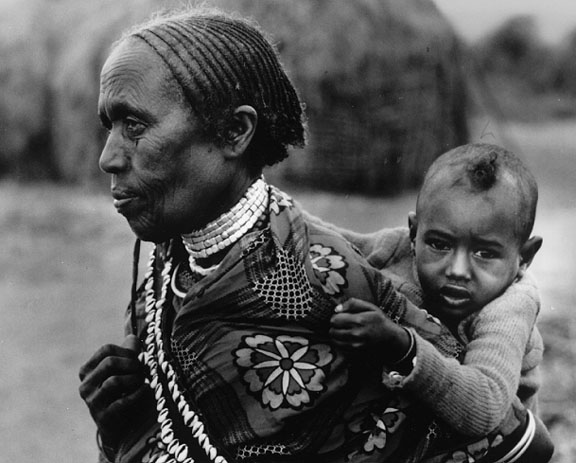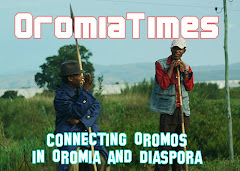
Oromia


Pictures: 1. From left to right, Lensa Dawano, Lalese Dawano and Barite Bati do a Ragadaa dance Friday at the Carlson School of Management during the Oromia Youth Association meeting. Oromia is largest of nine ethnic regions in Ethiopia in both population and landmass.
2. Miessa Gemeda, left, Hussen Ejero, center, and Tibeso Foge goof around Friday at the Oromia Youth Association meeting; Tyler McKean
Oromo youths yearn for freedom
By Bryce Haugen
few people have heard of his homeland in the Horn of Africa, but Edao Dawano is willing to die for its freedom.
The University biology sophomore effuses indescribable passion when talking about Oromia, a formerly independent region controlled by Ethiopia, and he wears its unrecognized flag proudly.
Tyler McKean
The red lines, Dawano said, represent the blood shed for freedom, while the green depicts the region's lush land. The star means unity, while the yellow background stands for the future, "when we will shine like the sun."
Dawano is president of the Oromia Youth Association, a group of about 100 high school and college students who aim to share the Oromo people's rich but largely unknown history and culture with youths of all colors. The University student members also belong to the Oromia Student Union. Both groups meet regularly, often teaming up on events and projects.
They rallied at the Capitol on Thursday with hundreds of local Oromo to protest the Ethiopian government's recent involvement in Somalia. The government, group members said, is systematically killing Oromo refugees in the lawless nation.
Most members are vehement nationalists, bent on establishing an independent Oromia nation within Ethiopia, which has been controlled by other ethnic groups for its entire existence. And most members witnessed torture and death firsthand, though they'd rather talk about freedom than dwell on a painful past.
Dawano refuses to elaborate on his personal story, beyond the fact he came to America in 1999 via a Kenyan refugee camp.
"My story is the same as every Oromo that's been oppressed," he said. "Our struggle is to reclaim what we've lost."
He said he and many of his peers are willing to take action to right historical wrongs. Ideally, freedom would be achieved through political discourse, but if it takes "blood and iron," Dawano said he's willing to fight.
"Freedom is not going to come to you freely; we have to fight for it and use all means necessary," he said. "I will 100 percent go back, and I will do the best of my ability to make sure my people are free from our oppressors."
One of the student groups' fundamental goals, he said, is to cultivate the future leaders of an independent Oromia.
But more immediately, in the local Oromo community, these student groups play a vital role in overcoming institutionalized barriers most immigrants face, said Jennifer Blevins, community and systems change director for Family and Children's Service, a Minneapolis-based nonprofit.
"The role of the student as the second generation is very important in cultural preservation and for building the economic and political capital for the people of their generation," she said.
Perhaps the most important means to that end is education, a value Oromo immigrants see as key to political and economic opportunity.
"I'm not in America to live the so-called American dream life," said Dawano, who graduated from a Family and Children's Service leadership training program in November. "I'm here to get educated and then take it back to my people."
The Ethiopian Twin Cities' diaspora - the largest concentration in America, estimated at between 7,500 and 15,000 people - is better-educated and of a higher socioeconomic status than some other immigrant groups, said University sociology professor Elizabeth Boyle, an expert in migration.
To promote education, the Oromia Youth Association tutors at local high schools, encouraging Oromo students to pursue higher education and join the group.
At a meeting Friday at the Carlson School of Management, the high school OYA members proudly proclaimed their plans to attend college.
"If you're an Oromo, it's not really a choice," said Lalese Dawano, a junior at Edina High School and Edao's sister. "You have to go. That's the way to get your freedom - to get educated. We cannot just wait for freedom to come."
As valuable as education is to all groups, Ethiopian immigrants of other ethnicities have said the Oromo population exaggerates their plight.
The government abuses all ethnicities indiscriminately, said Ethiopian Student Association social chairwoman, Meron Ashenafi. Before she moved to Minneapolis four years ago, the medical technologist junior lived harmoniously with Oromo neighbors, she said.
She would prefer that her group and the Oromia Student Union unite as Ethiopians and work collectively on projects, but so far OSU members have declined.
"They're not a country; (Oromia) doesn't exist," she said. "They're still Ethiopians. And when you try to explain that, they sometimes get unreasonable."
But the debate sticks to the intellectual realm, virtually never resorting to violence.
Ziyad Kadir, a mechanical engineering junior at the Duluth campus, uses art to promote his political perspective. Using the pen name Big Z, Kadir therapeutically explains his painful adolescence through poetry.
"It has a special power," said Kadir, one of about a dozen Oromo students in Duluth. "It makes me happy saying what's inside my heart."
http://www.mndaily.com/articles/2007/01/31/70537



2 comments:
A gorgeous alternative to the traditional engagement rings, each of
the stones in the three-stone ones stands for the different
stages a relationship goes through - the past, the present and the future.
While we don't think of divorce as being very common in the 1920's, this newspaper article
stated the need for the divorce ring due to "divorce having become so frequent that it is considered there is a need for a distinctive emblem. In fact, some young teen stars are causing quite a buzz with something that seems to be far more than just the latest teenage trend.
Look at my weblog :: promise rings custom
Now what thee - Bookdoes is explain to you step by step guides on
cutting your acne footprint and ensuring your acne problem
becomes the one that doesn't inflame itself further to the future. Yoga: Do yoga as yoga will release your stress levels and when your stress levels levels are decreased then you will definitely get a high self 'esteem.
Under the Kiss Organics manufacturer product line from Kiss My Face,
the arrival of organic personal care products created from wild-crafted and organic ingredients gained in popularity.
Marvin Pomerantz relates that particular hospital's usage of an aerosolized treatment increased pneumonia patients' coughing and thereby
designed a virtual TB epidemic one of the staff.
Feel free to visit my website: manuka honey acne :: :
:
Post a Comment